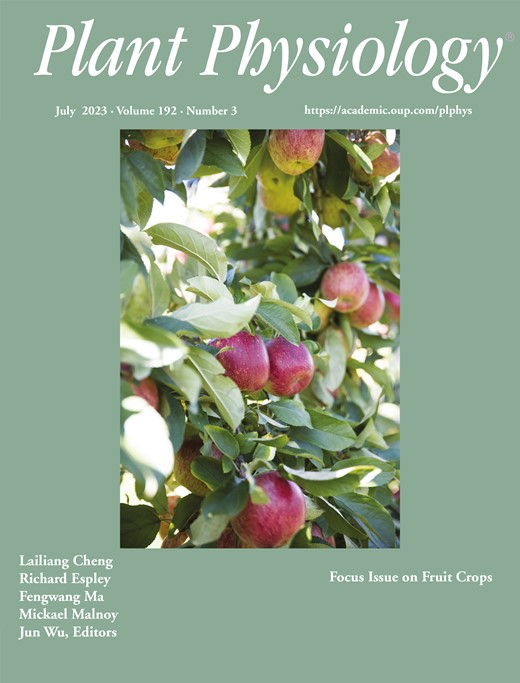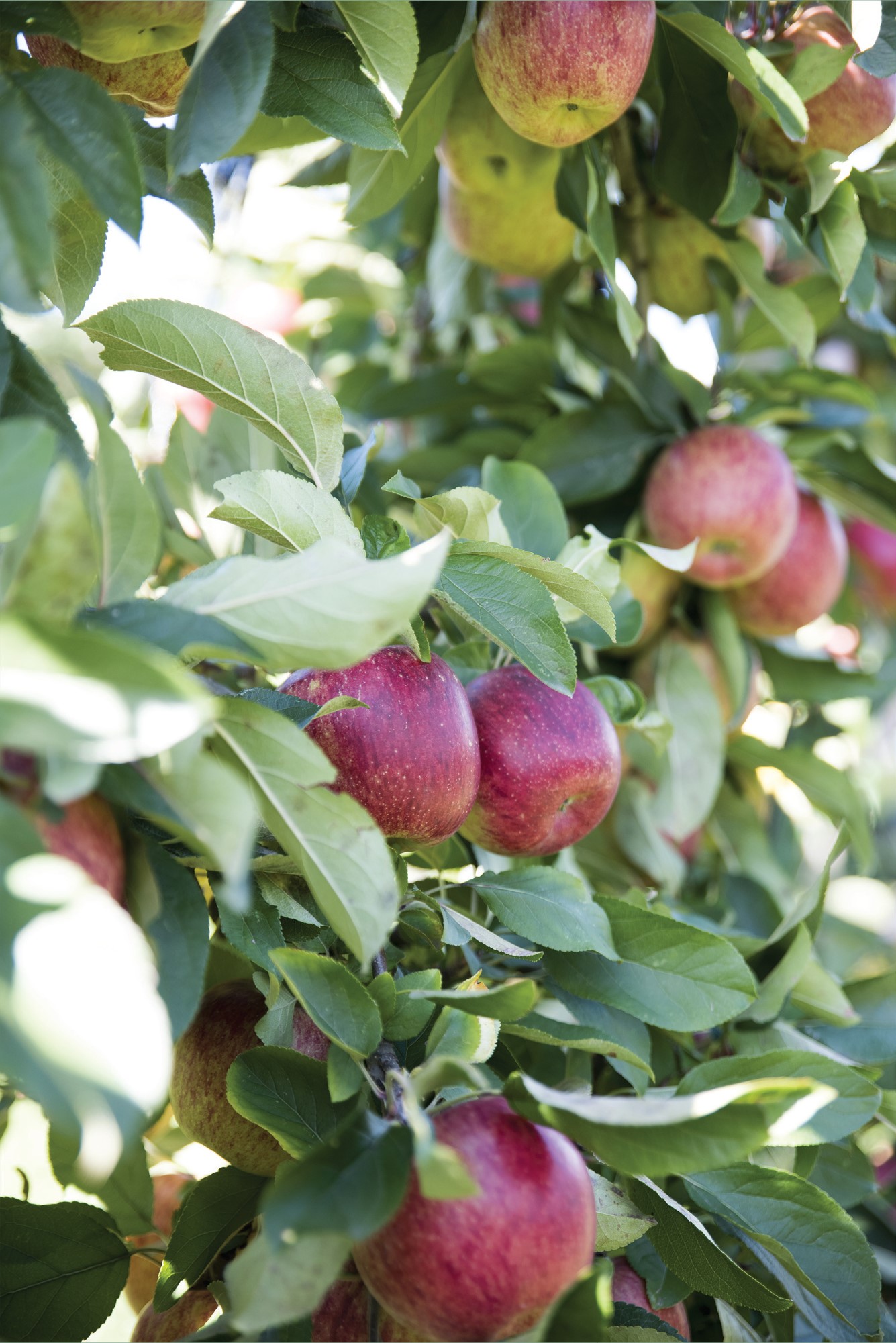
Cover image

Volume 192, Issue 3, July 2023
Focus Issue on Fruit Crops
Focus Content
Editorial
Focus on fruit crops
News and Views
A microRNA with a mega impact on plant growth: miR156ab spray keeps drought away
How sweet! Transcription factor CitZAT5 regulates CitSUS5 and CitSWEET6 to promote sugar accumulation in citrus fruit
Update
Genes and Development
Insights into cell wall changes during fruit softening from transgenic and naturally occurring mutants
Insights into cell wall changes during fruit softening from studies on transgenic and naturally occurring mutants.
L-Ascorbic acid metabolism and regulation in fruit crops
Vaccinium as a comparative system for understanding of complex flavonoid accumulation profiles and regulation in fruit
Recent advances in epigenetic triggering of climacteric fruit ripening
DNA methylation and histone modification, including methylation and acetylation, are possible triggering factors involved in the onset of climacteric fruit ripening.
Metabolism
Colorful hues: insight into the mechanisms of anthocyanin pigmentation in fruit
Research progress in the regulation of developmental cues, hormones, environmental factors and their crosstalk in fruit anthocyanin accumulation has significantly advanced in recent years.
Signaling and Response
Advances in understanding cold tolerance in grapevine
Experimental approaches in studying active biomolecules modulating fruit ripening: Melatonin as a case study
Proof from various complementary experimental approaches is needed to assign a specific regulatory function to active biomolecules.
Fruit crops combating drought: Physiological responses and regulatory pathways
Topical Review
Genes, Development and Evolution
Current insights into posttranscriptional regulation of fleshy fruit ripening
Various posttranscriptional, translational, and posttranslational mechanisms constitute the molecular framework of fruit ripening.
Research Articles
Cell Biology
Riboflavin mediates m6A modification targeted by miR408, promoting early somatic embryogenesis in longan
MicroRNA408 targets a previously unknown gene, regulates riboflavin biosynthesis, and mediates m6A modification and RNA homeostasis, promoting cell division and early somatic embryogenesis in longan.
Ecophysiology and Sustainability
Hydraulic tradeoffs underlie enhanced performance of polyploid trees under soil water deficit
Vigorous triploids and dwarf tetraploids show diverging vascular porosity but higher plant hydraulic efficiency under soil water scarcity compared with diploids.
Genes and Development
MicroRNA156ab regulates apple plant growth and drought tolerance by targeting transcription factor MsSPL13
The microRNA156ab-SQUAMOSA PROMOTER BINDING PROTEIN-LIKE13 module facilitates auxin biosynthesis to promote plant growth and enhance drought resistance in apple.
The transcription factor CitZAT5 modifies sugar accumulation and hexose proportion in citrus fruit
The transcription factor CitZAT5 participates in sugar metabolism and transport by regulating CitSUS5 and CitSWEET6, promoting sugar accumulation and increasing hexose proportion in citrus fruit.
Allelic variation of MdMYB123 controls malic acid content by regulating MdMa1 and MdMa11 expression in apple
Competitive binding effect between MdMYB123 and mdmyb123 results in differential expression profiles of MdMa1 and MdMa11, which leads to variation in malic acid content.
ETHYLENE RESPONSE FACTORS 4.1/4.2 with an EAR motif repress anthocyanin biosynthesis in red-skinned pears
A regulatory feedback loop mechanism involving repressor ETHYLENE RESPONSE FACTORS 4.1/4.2 balances anthocyanin overaccumulation in red-skinned pears.
Transcription factor LcNAC002 coregulates chlorophyll degradation and anthocyanin biosynthesis in litchi
Degreening and reddening during ripening of litchi fruit is under the control of a regulatory gene, LcNAC002.
The transcription factor VviNAC60 regulates senescence- and ripening-related processes in grapevine
The transcriptional factor VviNAC60 regulates organ maturation initiation in grapevine, promoting anthocyanin synthesis, chlorophyll degradation, cell death, and other senescence-related processes.
Citrus ACC synthase CiACS4 regulates plant height by inhibiting gibberellin biosynthesis
CiACS4 is activated by an ethylene reaction factor (CiERF023), forms a complex with CiERF3, and then binds to the promoters of CiGA20ox1 and CiGA20ox2 to regulate plant height in citrus.
E3 ligase MaNIP1 degradation of NON-YELLOW COLORING1 at high temperature inhibits banana degreening
E3 ubiquitin ligase MaNIP1 and chlorophyll catabolic enzyme MaNYC1 form a regulatory module to mediate high-temperature-induced green ripening.
ABRE-BINDING FACTOR3-WRKY DNA-BINDING PROTEIN44 module promotes salinity-induced malate accumulation in pear
The transcription factor PpABF3 activates PpWRKY44 expression, and they coordinately regulate salinity-enhanced malate accumulation by regulating aluminum-activated malate transporter 9 in pear.
The transcription factor PbrMYB24 regulates lignin and cellulose biosynthesis in stone cells of pear fruits
The transcription factor PbrMYB24 regulates lignin and cellulose biosynthesis in stone cells of pear fruits by binding to different cis-elements
MdERF114 enhances the resistance of apple roots to Fusarium solani by regulating the transcription of MdPRX63
Two B-box proteins, PavBBX6/9, positively regulate light-induced anthocyanin accumulation in sweet cherry
The B-box proteins PavBBX6 and PavBBX9 positively regulate ABA biosynthesis and red coloration in bicolored sweet cherry fruit in the light.
Geonmics and Evolution
A multifunctional true caffeoyl coenzyme A O-methyltransferase enzyme participates in the biosynthesis of polymethoxylated flavones in citrus
Caffeoyl-CoA O-methyltransferase methylates different phenolic compounds with a preference for flavonoids in vitro and promotes the accumulation of multiple polymethoxylated flavonesins in citrus.
Metabolism
ETHYLENE-INSENSITIVE 3-LIKE 2 regulates β-carotene and ascorbic acid accumulation in tomatoes during ripening
ETHYLENE INSENSITIVE 3-LIKE 2 controls β-carotene and ascorbic acid biosynthesis in tomato fruits via different regulatory pathways.
Abscisic acid and regulation of the sugar transporter gene MdSWEET9b promote apple sugar accumulation
Transcriptomic and metabolomic analysis reveals a protein module involved in preharvest apple peel browning
SnRK1 kinase-mediated phosphorylation of transcription factor bZIP39 regulates sorbitol metabolism in apple
SnRK1 kinase modulates sorbitol metabolism in apple via phosphorylation of transcription factor bZIP39, which integrates sorbitol signaling into the SnRK1-mediated sugar signaling network.
Signaling and Response
The RNA-binding protein MdHYL1 modulates cold tolerance and disease resistance in apple
MdHYL1 acts as a positive regulator of cold tolerance and disease resistance in apple via positively regulating the expression of MdMYB88 and MdMYB124 as well as miRNA biogenesis.
Elevated methylglyoxal levels inhibit tomato fruit ripening by preventing ethylene biosynthesis
Methylglyoxal detoxification, catalyzed by glutathione-dependent glyoxalase I and regulated by the MADS-box transcription factor RIPENING INHIBITOR, is crucial for fruit ripening.
Persulfidation of transcription factor MYB10 inhibits anthocyanin synthesis in red-skinned pear
A regulatory mechanism involving H2S-mediated MYB10 persulfidation represses anthocyanin accumulation in red-skinned pears.
Transcription factors MhDREB2A/MhZAT10 play a role in drought and cold stress response crosstalk in apple
The transcription factor MhDREB2A activates MhZAT10 expression, and they coordinately regulate drought and cold stress by integrating multiple pathways in apple rootstock to improve shoot-shriveling tolerance.
Regular Content
News and Views
Timekeeper's dilemma: How photo-thermal cues alter flowering duration
Beyond the genetics of flowering: Integration of ethylene signaling and histone methylation controls flowering time
A starch- and ROS-regulating heat shock protein helps maintain male fertility in heat-stressed rice plants
Encoding wild fragrance: The role of allelic variants in floral odor emissions
It's not you, it's me: Extracellular self-DNA signals through the jasmonic acid pathway
Ubiquitination of PHYTOSULFOKINE RECEPTOR1 regulates plant immunity
sic-4 Reports in sick! Loss of SICKLE induces salicylic acid-dependent cell death in Arabidopsis
“Smother love” of mycorrhiza: hypoxic germination of orchids
Research Articles
Cell Biology
Multi-copper oxidases SKU5 and SKS1 coordinate cell wall formation using apoplastic redox-based reactions in roots
Multi-copper oxidases SKU5 and SKS1 modulate reactive oxygen species homeostasis in root apoplast to regulate cell wall formation.
Ecophysiology and Sustainability
Large root cortical cells and reduced cortical cell files improve growth under suboptimal nitrogen in silico
Enlarged root cortical cells and reduced cortical cell file number decrease the metabolic cost of soil exploration, thereby improving plant growth under suboptimal nitrogen availability.
Genes and Development
FLOWERING LOCUS T mediates photo-thermal timing of inflorescence meristem arrest in Arabidopsis thaliana
Temperature and day length control the duration of flowering in Arabidopsis through the floral integrator FLOWERING LOCUS T.
ETHYLENE INSENSITIVE3/EIN3-LIKE1 modulate FLOWERING LOCUS C expression via histone demethylase interaction
ETHYLENE INSENSITIVE3 (EIN3) and its homolog EIN3-LIKE1 regulate floral transition by recruiting histone demethylase FLOWERING LOCUS D to modulate transcription of floral repressor FLOWERING LOCUS C.
Rice HEAT SHOCK PROTEIN60-3B maintains male fertility under high temperature by starch granule biogenesis
During rice pollen development, a heat shock protein interacts with and stabilizes a starch-binding protein to ensure normal starch granule biogenesis under high temperature.
Chloroplast SRP54 and FtsH protease coordinate thylakoid membrane-associated proteostasis in Arabidopsis
Targeting a dysfunctional GFP fusion protein to a thylakoid identifies the coordination of the thylakoid translocation pathway and the FtsH protease on thylakoid membrane-associated proteostasis.
Modulating auxin response stabilizes tomato fruit set
Modulating the activity of auxin response factors increases yield in extreme temperatures in a dose-dependent manner.
PbrBZR1 interacts with PbrARI2.3 to mediate brassinosteroid-regulated pollen tube growth during self-incompatibility signaling in pear
The brassinosteroid-activated transcription factor BRASSINAZOLE-RESISTANT1 regulates pollen tube growth during self-incompatibility signaling in pear.
Genomics and Evolution
Transcriptome and DNA methylome divergence of inflorescence development between 2 ecotypes in Panicum hallii
A comparative transcriptome and DNA methylome analysis of different stages of inflorescence between upland and lowland ecotypes reveals gene expression and DNA methylation divergence in Panicum hallii.
The 2020 derecho revealed limited overlap between maize genes associated with root lodging and root system architecture
Complex regulatory networks of physiological and biochemical pathways influence root lodging in maize, with limited overlap of genes associated with lodging resistance and root system architecture.
Membranes, Transport, and Bioenergetics
Natural variation of maize root hydraulic architecture underlies highly diverse water uptake capacities
The natural variation of the anatomy, system architecture, and hydraulic capacity of maize roots, which together shape the root hydraulic architecture, reveals a high diversity of water uptake strategies in this species.
Metabolism
Allelic variation of terpene synthases drives terpene diversity in the wild species of the Freesia genus
The relationship between floral scent and allelic variation of TERPENE SYNTHASE in representative wild species reveals the molecular basis of interspecific floral diversity among Freesia species.
Signaling and Response
COLD REGULATED GENE 27 and 28 antagonize the transcriptional activity of the RVE8/LNK1/LNK2 circadian complex
COLD REGULATED GENE 27 and 28 bind to and antagonize the ability of the circadian clock–associated RVE8/LNK complex to induce target gene expression in the evening in Arabidopsis thaliana.
The trans-zeatin-type side-chain modification of cytokinins controls rice growth
The trans-zeatin-type cytokinins are biosynthesized via the cytochrome P450 monooxygenases CYP735As and control growth of both roots and shoots in rice.
Plant extracellular self-DNA inhibits growth and induces immunity via the jasmonate signaling pathway
RNA-sequencing, hormone measurement, and genetic analysis show that extracellular self-DNA-mediated growth inhibition and immunity induction are achieved through the jasmonic acid signaling pathway.
XAP5 CIRCADIAN TIMEKEEPER regulates RNA splicing and the circadian clock by genetically separable pathways
XCT plays genetically separable roles in controlling the fidelity of 3' splice site selection during pre-mRNA splicing and the pace of circadian clock in Arabidopsis.
Ubiquitylation of PHYTOSULFOKINE RECEPTOR 1 modulates the defense response in tomato
Phytosulfokine inhibits plant U-box E3 ligase-mediated ubiquitylation of PHYTOSULFOKINE RECEPTOR 1 (PSKR1) to trigger plant defense against Botrytis cinerea in tomato.
Absence of SICKLE triggers programed cell death by disturbing alternative splicing and decay of mRNAs
SICKLE is involved in the regulation of salicylic acid-triggered programmed cell death in Arabidopsis by affecting alternative splicing and decay of mRNAs.
Rice microRNA156/529-SQUAMOSA PROMOTER BINDING PROTEIN-LIKE7/14/17 modules regulate defenses against bacteria
Bacterial pathogens hijack host rice microRNA-regulated signal transduction to compromise salicylic acid- and jasmonic acid-mediated immune responses.
Symbiosis between Dendrobium catenatum protocorms and Serendipita indica involves the plant hypoxia response pathway
ADH and the related hypoxia-responsive pathway of D. catenatum protocorms regulate interactions with Serendipita indica, which is determined to be a broad-spectrum orchid-germinating OrM fungus.





















































